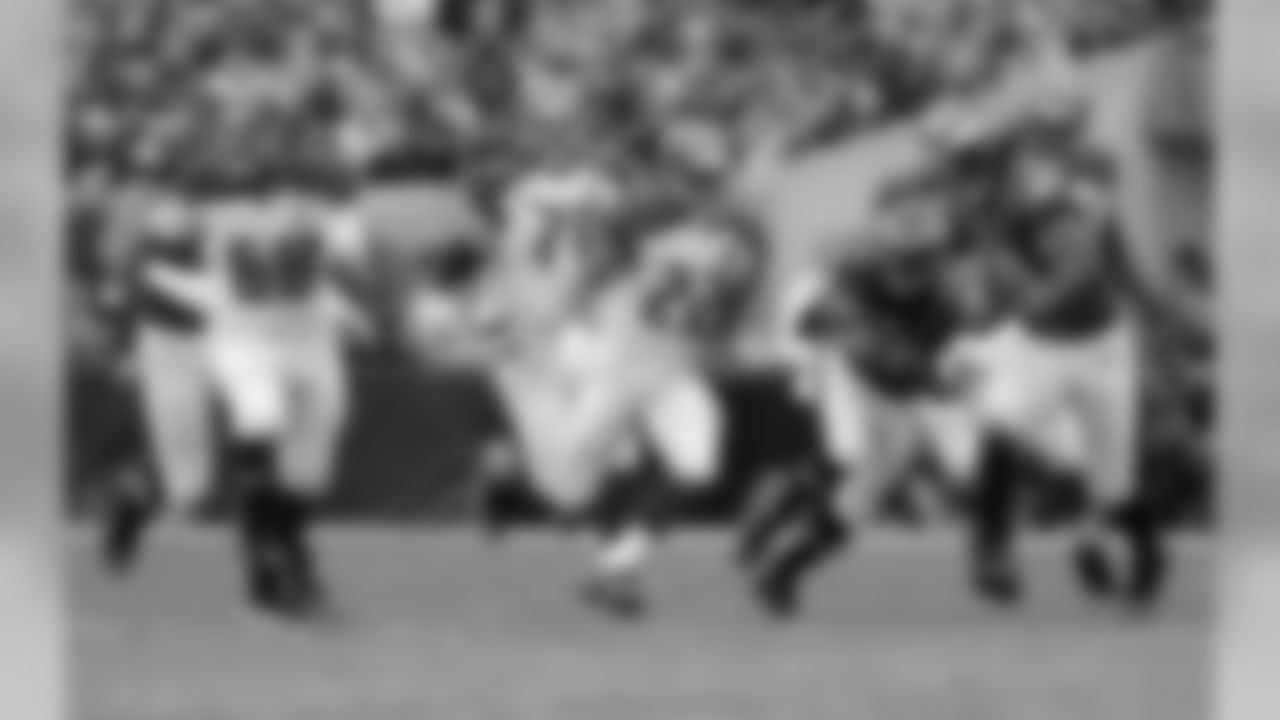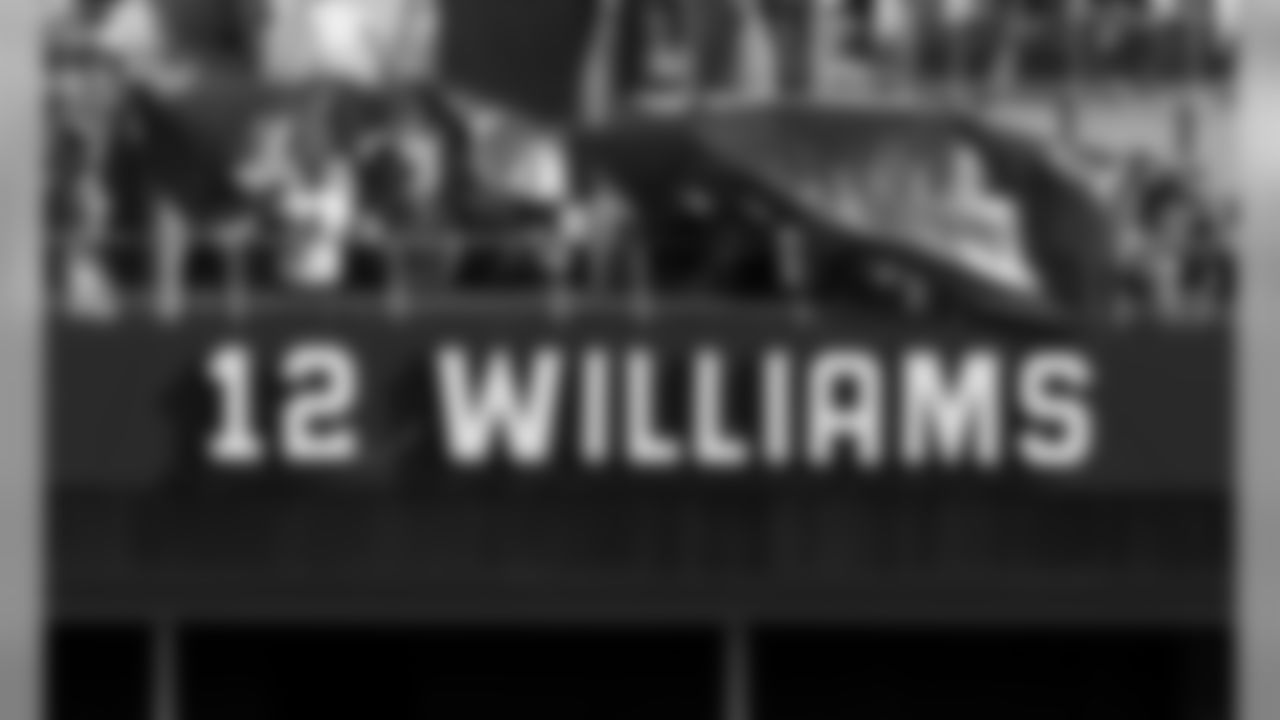NFL.com's Daniel Jeremiah's predictions for the first round of the 2016 NFL Draft.

- Broncos: OT Le'Raven Clark - Texas Tech

- Panthers : DE Shaq Lawson - Clemson

- Cardinals: FS T.J. Green - Clemson

- Chiefs: DE Kevin Dodd - Clemson

- Packers: DT Andrew Billings, Baylor

- Seahawks: DT Chris Jones - Mississippi State

- Steelers: CB Artie Burns - Miami

- Bengals: WR Josh Doctson - TCU

- Vikings: WR Laquon Treadwell - Ole Miss

- Texans: TE Hunter Henry - Arkansas

- Redskins: DT Jarran Reed - Alabama

- Jets: QB Paxton Lynch - Memphis

- Bills: LB Reggie Ragland - Alabama

- Colts: CB Eli Apple - Ohio State

- Falcons: LB Darron Lee - Ohio State

- Lions: C Ryan Kelly - Alabama

- Titans: OT Taylor Decker - Ohio State

- Oakland: CB William Jackson III - Houston

- Dolphins : RB Ezekiel Elliott - Ohio State

- Saints: DT Sheldon Rankins - Louisville

- Bears: LB Leonard Floyd - Georgia

- Giants: OT Jack Conklin - Michigan State

- Buccaneers: CB Vernon Hargreaves - Florida

- Eagles: OT Ronnie Stanley - Notre Dame

- 49ers: QB Jared Goff - California

- Ravens: OT Laremy Tunsil - Ole Miss

- Jaguars: DE DeForest Buckner - Oregon

- Cowboys: DE Joey Bosa - Ohio State

- Chargers: CB Jalen Ramsey - Florida State

- Browns: LB Myles Jack - UCLA

- Rams: QB Carson Wentz - North Dakota State
Ten players from the Tampa Bay Buccaneers' 2015 roster, including leading rusher Doug Martin, are due to become unrestricted free agents on March 9. Because they have at least four accrued NFL seasons and expiring contracts, these 10 Bucs will have the opportunity to dictate where their professional careers will continue.
Though it has been tweaked here and there since its inception in 1993, the NFL's free agency system has remained mostly the same for more than two decades, even as new collective bargaining agreements (CBAs) have been signed into place. That includes the existence of "franchise tags," which were put into the original CBA with the intention of helping teams (especially smaller-market teams) retain their very core players, even on the open market. In other words, the franchise tag was supposed to help teams protect their franchise players; the example commonly cited at the time was Denver quarterback John Elway.
The first player to get a franchise tag was Washington linebacker Wilber Marshall, which led to a full offseason of acrimony and an eventual trade to the Houston Oilers. Technically, Philadelphia had used their available franchise tag a few days earlier on defensive end Reggie White, but as a named plaintiff in the suit that had helped speed up the CBA negotiations, White was given full free agency and the Eagles' move was only about potential compensation.
Nine players in total received a franchise tag in that first year of free agency, including Tampa Bay offensive tackle Paul Gruber. Gruber had just finished his fifth season after being the fourth overall draft pick in 1988, and he had famously never missed an offensive play in that span, a streak of 4,850 snaps. That run ended in 1993 because the tag led to a contract dispute that wasn't resolved until October, after he had missed five games.
Obviously, the franchise tag was not warmly received by many players, and it still isn't the favored option for most pending free agents. While it promises a top salary comparable to other players at the same position, it is also just a one-year deal and most players would prefer an opportunity to establish long-term security. That said, teams that apply a franchise tag usually are just, in essence, extending the negotiation period in order to hammer out such a long-term deal.
RB Doug Martin led the NFL in rushes over 20 yards. Check out his 20+ yard gains in ascending order.








































So, the franchise tag persists, and as in that first year it is commonly used by about 10 teams per season. In fact, an average of 9.5 players per year have received a franchise tag over the last decade, though it has fluctuated from a low of three in 2006 to a high of 19 in 2012. There were six players tagged in each of the past two offseasons.
The Buccaneers have utilized the franchise tag option three more times since first using it on Gruber. Most recently, Connor Barth was given that designation in 2012, which led to a long-term deal being signed that offseason. Barth was one of six punters or kickers who were tagged in 2012, which is an indication of how the perception of that option has changed over the past quarter-century. The salary that a tagged kicking specialist would receive if he accepts the tender offer, while good in comparison to his peers, is not as onerous of a commitment as a team would have to give to, say, a quarterback. Only one quarterback has been tagged in the last four years, as the Saints used their franchise designation on Drew Brees in 2012 before hammering out a new deal.
Between Gruber in 1993 and Barth in 2012, the Buccaneers used their franchise tag on defensive lineman Chidi Ahanotu in 1999 and wide receiver Antonio Bryant in 2010. Neither move really resulted in the Bucs' locking up a "franchise" player. Ahanotu was part of a star-studded Tampa Bay roster, particularly on defense, and he hit the market at the right time, as that tag led to a new six year deal. But Ahanotu would play just two more seasons as a Buccaneer (not counting a brief return in 2004), collecting 10 sacks in that span.
Bryant signed with the Buccaneers in 2008 after being out of the league in 2007 and had an enormous bounce-back season. In fact, with 83 catches for 1,248 yards and seven touchdowns, he put together one of the best seasons ever for a Tampa Bay wideout, and the Bucs used the franchise tag to keep the rejuvenated Bryant from bouncing on to another team. Bryant played the 2009 season on that expensive tag but was limited by injuries to 39 catches and never played again in the NFL after that campaign.
Originally, if a player signed a long-term deal after being franchise-tagged, that tag remained tied to that new contract throughout its length, which helps explain why only Gruber and Ahanotu got those Buccaneer designations between 1993 and 2009. That is no longer the case, however, so teams are free to use their one franchise tag every offseason, if they deem it necessary or prudent.
So, obviously, the Buccaneers have that option again this year. Are they like to use it on any of those aforementioned 10 pending free agents? First, let's specify the three options open to the team: exclusive franchise tag, non-exclusive franchise tag and transition tag.
The transition tag is rarely used these days because, unlike the franchise tags, it does not include a provision for compensation for the original team if the tagged player signs elsewhere. Since there often is not a huge difference between the salary requirements for transition and franchise tags, there usually isn't much incentive to go for the former over the latter.
Check out some of the best photos shot by the photographers of the Tampa Bay Buccaneers during the 2015 season.






















































































































As for the two types of franchise tags, the difference is in compensation, for both the player and the team. The exclusive tag keeps the tagged player from negotiating with any other team but requires a higher tender offer, which is calculated by averaging the top five salaries at the player's position as of April of the current year. Additionally, if 120% of the tagged player's previous year salary is a higher figure than the top-five average, he gets that number instead.
The formula for the non-exclusive franchise tag is much more complicated, involving the average of top-five cap hits over the previous five years, but it returns a lower number. The team that chooses this option, however, still risks losing the player, though it's generally a small risk. That's because the original team has the right to match any outside offer and if they do not match they receive two first-round draft picks in compensation.
The Buccaneers will probably make it four straight years without the use of the franchise tag, and that wouldn't put them in exclusive company. Tampa Bay is one of 16 teams that has not used a tag since 2012, heading into 2016. We discussed the Bucs' 10 pending unrestricted free agents on Monday; in addition to Martin, that list consists of Da'Quan Bowers, Chris Conte, Larry English, Mike Jenkins, Tony McDaniel, Henry Melton, Sterling Moore, Bobby Rainey and Keith Tandy.
Most of that list consists of depth from a 2015 defense that struggled for much of the year. Several of those players may return and prove productive for the team in 2016, but none are in line for a franchise tag. Neither running back Bobby Rainey nor safety Keith Tandy, both of whom primarily contributed on special teams in 2015, are candidates for a tag either, though they have performed well for the team.
That leaves Martin, who was the NFL's second-leading rusher in 2015 and one of the centerpieces of an offense that broke a slew of team records. Martin figures to be one of the Buccaneers' most important decisions before – and perhaps after – the start of free agency on March 9, but he too seems an unlikely candidate for a franchise tag.
The reason for that is Martin's position. If quarterbacks rarely get tagged, it's because teams that want to keep a good passer generally find a way to do so before it gets down to that option. Kirk Cousins, who emerged as a strong starter during the second half of last season in Washington, could be a rare exception this year. Running backs are tagged even less frequently, especially in recent years, but – unlike at quarterback – that's because backs have increasingly come to be considered a more fungible asset.
Photos of the 2015-16 Tampa Bay Buccaneers Cheerleaders from auditions to their final game of the season.


































































































Only two running backs have been franchise-tagged over the last two decades, and the cost has increased fairly steeply since the last one. The Baltimore Ravens tagged Ray Rice in 2012 when the offer sheet for an exclusive tag at the position cost $7.7 million. Last year, a running back would have made nearly $11 million with a franchise tag, and this year the figure will probably be closer to $12 million. The Giants also tagged Brandon Jacobs in 2009.
The average NFL tenure at the running back position is shorter than most, and teams have learned that they can find good rushing talent throughout many NFL drafts. That makes mega-deals for veteran backs less common, though recent contracts for Adrian Peterson and Marshawn Lynch have helped drive up the average for calculating the franchise-tag tender. The 2015 Dallas Cowboys are a good example of the economics of the position; they had both running back DeMarco Murray and wide receiver Dez Bryant as pending free agents a year ago and, to no one's surprise, used their tag on Bryant. Murray, who had just turned 27, had led the NFL with 1,845 rushing yards and 13 rushing TDs in 2014 but was allowed to walk.
None of which is to say that running backs in general or Martin specifically are unimportant, interchangeable or any less worthy of getting a big deal in free agency. The 49ers chose not to tag long-time standout back Frank Gore last year, perhaps in large part because he was going to turn 32 in May and had already played 10 NFL seasons. Gore still got a three-year, $12 million contract from the Indianapolis Colts with more than half of it guaranteed.
Doug Martin was one of the NFL's best running backs in 2015 (and 2012, for that matter) and likely has many productive years ahead of him. Local fans hope those years come in a Buccaneer uniform, and they can if he and the team strike a new deal before or even after the start of free agency. The franchise tag could help guarantee that will happen, at least for one more year, but history suggests that move is unlikely. With no other reasonable candidates for the tag, the Bucs will probably be one of many teams not to utilize the franchise option in 2016.
























